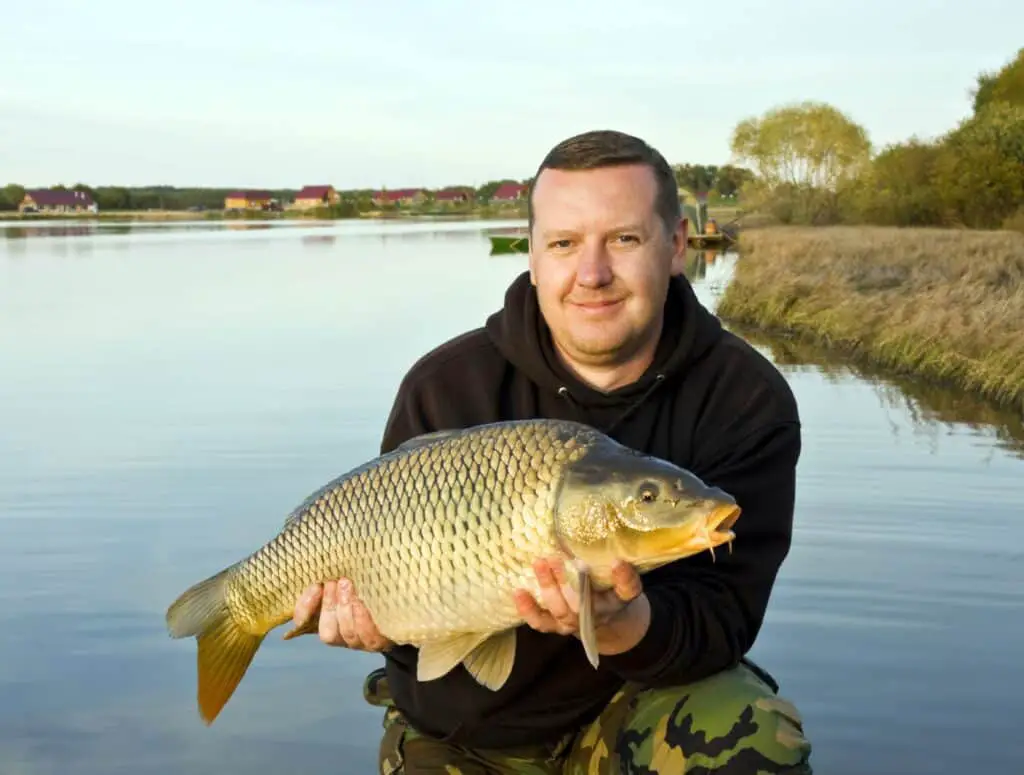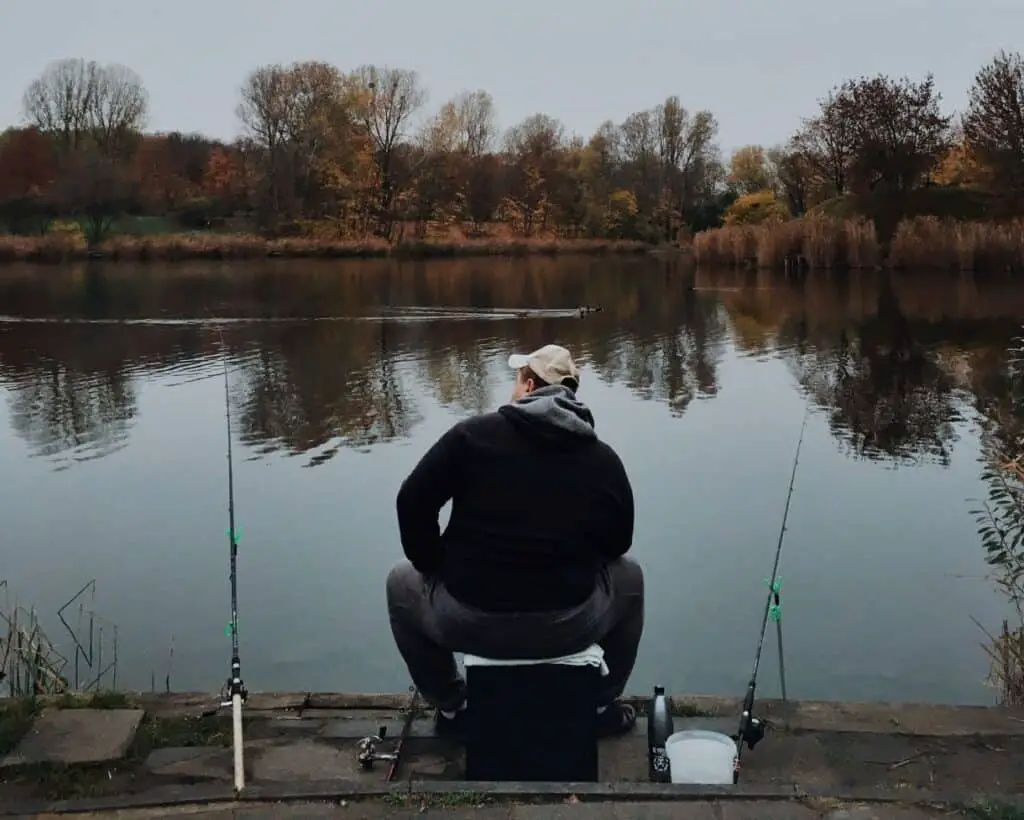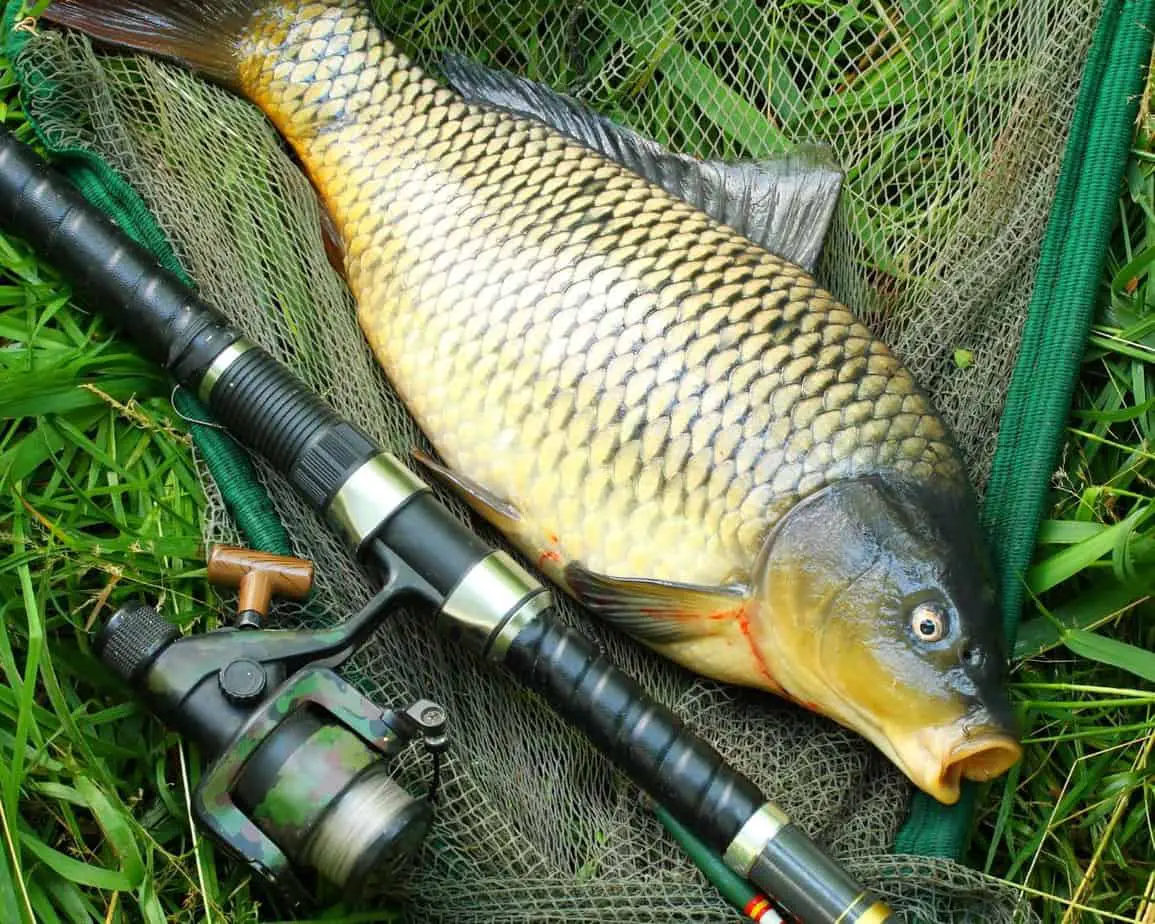North America is renowned for its carp fishing. They are a larger fish that anglers enjoy the challenge of due to their incredible power and fight. Did you know that you can eat carp?
But are carp good to eat?
The plain and simple answer is yes, carp are good to eat. It must be noted that it is better to have a live carp and keep it in fresh water for several days. This removes the mud vein, which for obvious reasons, improves the flavor. They are high in lean protein and omega-3s, which makes them a healthy meal as well!
The common carp originated in Asia and Europe and has a long history as a sought-after delicacy. In Europe, during the middle ages, it was a foodstuff reserved for royalty. Carp is still prepared as a cordon-bleu meal in many restaurants throughout Europe.
Yet, in the US, the thought of eating one of these majestic fish is still held in disdain. So, with the health benefits and the patronage of royals and fine diners in mind, let’s look to see if we can change your opinion.
The Best Way To Cook Carp
Preparing Carp
Preparation is the key to enjoying this fish. If you have caught your carp, keep it alive for a few days in fresh water, as this will clean impurities and improve the taste. Do not feed the carp in this period.
Once it is ready for the pot, you need to scale it by scraping from head to tail with a knife’s back. The scales of a carp are very large, measuring up to half an inch. You will need to apply pressure to descale the carp as the scales are hard to remove.
Gut the fish next by cutting from head to tail along the carp’s underbelly, then remove the innards, make sure you have left no guts in the cavity. Again, rinse the carp under running water.
Filleting requires a sharp knife, insert the knife’s tip into the back of the head just above the gill area and slice through the meat to the tail. Turn the carp over and repeat the process. Continue to cut through the meat along the rib cage to the underbelly of the fish. Carps have intramuscular bones. Remove these with pliers.
Skinning the carp is advised due to the mud vein or line which runs just under the skin. This will ensure your fish has a gentler and more delicate flavor. Skin the carp by placing skin down and slicing through the meat close to the skin. You need to apply pressure for this task, ensuring you remove the mud vein. You can do this by cutting a lateral line along the fish. Note the mud vein is of a darker color. Once again, rinse the fillet under running water and throw the remains away.
Ensure there are no fat deposits on the fish. If there are, remove them. Fatty deposits can contain PCBs (polychlorinated biphenyls), which are toxic compounds and can cause health issues if either eaten regularly or in large quantities.
Cooking Carp
Carp is quite a versatile fish to cook.
A simple way is baking it, for which all you need to do is to grease an ovenproof dish with butter, place your fillets on this, and top with slices of lemon to keep the fish moist. Bake in the oven at 350F for about ten to fifteen minutes. You can substitute the lemon with bacon. This will vary the flavor, but keep the moisture in.
To deep-fry carp, simply rinse and pat dry the fillets. Douse in flour first, then beaten egg, and coat in breadcrumbs. A beer batter mix is a tasty variation.
How about carp soup? Simple recipes are often the best. Just add chopped onion to a little butter into a saucepan. Add a chopped celery stick, a sprinkle of thyme, and some water, along with your fish. Add seasoning and simmer for thirty minutes. This can then be thickened with a flour and butter paste.
Casseroles are also a popular meal. Carp casserole is a simple but tasty dish to feed your family. And although there are many recipes, adapting basic recipes is always good to try.
The recipes for carp are quite endless, from Cajun spicy cooking to roasted whole or fillets, all using a variety of herbs, spices, and oils.
Here are some more options for carp recipes.
Eating Carp
Vegetables can be prepared in a variety of ways to accompany carp. A mix of lightly fried zucchini, carrot, bell pepper, and garlic is a great way to enjoy this fish’s flavor.
Finding different ways to cook and prepare potatoes is another good way to enjoy your carp.
From Sauvignon Blanc to beer to an iced tea, all will be perfect accompaniments to complement this amazingly versatile fish.
Other Noteworthy Information
Preparing and cleaning the carp before cooking is essential.
Smaller carp are tastiest, and it is recommended that larger carp are returned to the water.

Carp Fishing Tips and Techniques
Before you can try carp as a meal, you have to catch one.
There is something about fishing for common carp that makes it feel like you are a member of a secret club. These are magnificent beasts with strength and fight that really has to be experienced to be believed.
In this section, we will be covering some of the techniques that can be used to capture this worthy opponent.
In What Types Of Water Do You Find Carp?
Across the US, if there is a pond, lake, reservoir, river, there is an excellent chance that carp are resident. However, while fast-moving rivers that harbor trout and salmon populations may still have carp in them, the fishing conditions in these rivers make it unlikely you will catch them.
Aim for slower or still waters that have catfish, bass, or bluegill populations, and there will likely be a population of carp in there too. It is always worth checking with your local tackle dealer or local anglers as well.
Stalking Your Prey
Carp aren’t really a species that show themselves easily. Occasionally, in the early morning or towards dusk, they can get lively and jump a bit, but they are mostly an elusive species. When you see 25lbs carp on a shallow cruise with their broad backs breaking the surface, it is both a breath-taking and adrenaline-pumping moment.
Carp can be caught in any depth of water, but most carp anglers will target the shallow margins early in the morning or evening when carp are generally at their most active and feeding along the edges of reed beds or lily-pads. At other times they can tend to lie along shelves or drop-offs where the water level changes suddenly.
If you’ve fished for pike, many of the same methodologies can be applied to carp.
Best Time Of Year For Catching Carp
Carp can be caught year-round. However, in colder climates, they can become very lethargic in the winter and tend not to feed as often. It is usually best to fish shallower waters in the winter, where the water temperature can rise quickly. Spring through to Fall is when you are likely to have a better chance, however warmer winter days can still provide great sport.
As we noted, carp tend to feed when the light is low and often through the night, so dawn and dusk are the optimum times to fish, though they can be caught throughout the day.
Techniques For Catching Carp
Carp angling is generally shore-based, so there is no need for a boat and trailer. It can also be done using cheap and simple tackle, although it is best to be on the sturdy side for obvious reasons.
In this section, we will cover some of the fishing techniques and baits to use.
- Float Fishing – One of the great things about carp fishing is very often the only bait you will require is a loaf of bread! A simple rig using a small float as an indicator could be all you need. This method is excellent for fishing those drop-off areas.
- Free Lining – carp fishing is great for beginners because the tackle is simple and so are the basic techniques. And it doesn’t get any easier than free lining. With some bread, a can of sweetcorn, and some basic tackle, anyone can cast a line out.
With a simple rig of a hook and a slider weight, you can begin to search the margins along with the likes of reed beds. If permissible, it is often successful to ‘chum’ the water with whatever baits you are using.
Baits To Use
As noted above, sweat corn and bread are fantastic baits, particularly if you are just getting started and learning the techniques. However, to attract the bigger fish, most experienced carp anglers use ‘boilies.’ These come in various flavors, and two of the most popular in the US are Pineapple and Strawberry.
And let’s not forget the good old nightcrawlers. These can be a great bait for carp.

History Of Carp In The US
First, let’s clarify what we are talking about here. Recently, there have been negative headlines about Silver and Bighead carp’s encroachment in the Mississippi watershed and the great lakes. Mostly, when anglers talk about carp, we are talking about the ‘Common carp’ (Cyprinus carpio). This includes the sup-species Mirror carp, Leather carp, and even Koi carp. These are the species we will be covering here.
Although it is thought that carp arrived in the US in the 1830s, the history of the carp as a widespread species in the US dates back to 1871. At this time, the state of many of the main waterways was deteriorating. Already overfished, new towns were appearing all along main rivers. With no sewage systems to speak of human waste and industrial run-off was polluting the rivers and reducing oxygen levels, the native fish species were suffering.
A commission was set up to oversee the health of the nation’s waters and fish population. Carp was seen as a perfect solution, and in 1877, 6-years after its founding, it imported the first carp into the country. The first batch was 345, Mirror, Leather, and Common carp. These were placed in ponds in Baltimore and later in Washington D.C. This stock produced some 6,000 fingerlings, which were distributed to over 270 sites across 24 States.
Facts About Carp
Carp have been with us in the US for around a century and a half now. They have attracted a loyal band of anglers who dote on this mysterious and shy fish. Carp is an adaptable fish that prefers slow-moving rivers or still waters like lakes and ponds. Mostly they thrive in waters with silty bottoms but can also thrive in fast-moving rivers too.
Here are some fantastic carp facts:
- Long History of being farmed – People have appreciated this fish as foodstuff for centuries. The history of this species being farmed dates back to at least Roman times. This was continued after the fall of the Roman Empire, mainly by European Monasteries. In Asia, particularly China, Japan, and Korea, it may have been farmed for even longer, with some records suggesting it has been farmed since the third-century B.C.
- Non-Native Species – One of the reasons they are now so common worldwide is that carp are the third most commonly introduced species the world over.
- Long-Lived – In the wild, carp can live up to 20 years. However, in captivity, there have been fish that have lived to nearly 50 years old.
- Can grow to be huge – The record carp was caught at the Etang La Saussaie Fishery in France in 2013. It weighed in at 100.5lbs! Even if you don’t catch a hundred-pounder, the carp’s average size is between 5 and 31lbs. They can measure up to 32”.
- Omnivorous – carp will happily dine on whatever is on offer, although they do prefer scavenging for crustaceans, worms, nymphs, and insects. They will also quite happily graze on aquatic plants.
- Three Main Subspecies- The main subspecies across the US are the common or scale carp, the mirror carp, which is identified by several rows of large scales that run along its side. On the rest of its body, there are none. Finally, there is the Leather carp. This species had little or even no scales. Instead, as the name suggests, it has thick, almost leathery skin.
- Koi carp – These are a domestic species of carp that have been selectively bred for their color and appearance and are commonly used to stock garden ponds.
- Goldfish are carp – Goldfish are also a result of domestic breeding programs and were first mentioned in recorded history during the Jin Dynasty in China in the third century A.D. They are a smaller member of the carp family, hence their popularity in indoor aquariums.
- American Record – Daniel Slaby pulled a 54lb 8oz carp from a lake in Michigan on 11th November 2013.
- Common Food Source – Except for Australia and the US, carp is a common food source worldwide.
- Can Decrease Water Quality – Because of their bottom-feeding existence, carp have been known to decrease their habitat’s water quality to the detriment of native species. Carp will work their way along the bottom, effectively siphoning the mud as they go and spitting it back out again. This can cloud the water and deprive the vegetation of sunlight and make it difficult for prey fish to hunt.
Conclusion
Well, there you have it, carp caught, cleaned, and cooked. One thing to note here is that if you do intend to eat a carp, then smaller is best for this, and it is important to release the bigger fish returned to the water as they help control the population of carp. Ideally, you should release any fish over 10lbs.
We hope you enjoyed this article and it persuaded you to try catching and cooking a carp. If you did, you are bound to enjoy some of the other articles in this series, and why not let others into the secret world of carp fishing by sharing this article on social media or pinning it on Pinterest.
If you find this article helpful, don’t leave without sighing up for our newsletter and checking out our Recommended Fly Fishing Gear List.
Don’t forget to check out our other Fish Guide articles.
- Are Bass Good To Eat?
- What’s the Difference Between Trout and Salmon?
- Are Bonefish Good To Eat?
- What’s the Difference Between Carp and Buffalo Fish?
- Are Pike Good To Eat?
- The 7 Best Secret Rainbow Trout Baits
- Best Powerbait For Stocked Trout
- What Is The Difference Between Walleye And Pickerel?
- What Is A Tiger Trout? Where to Find One and How To Catch One


